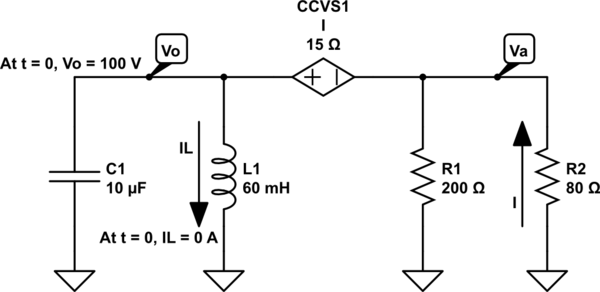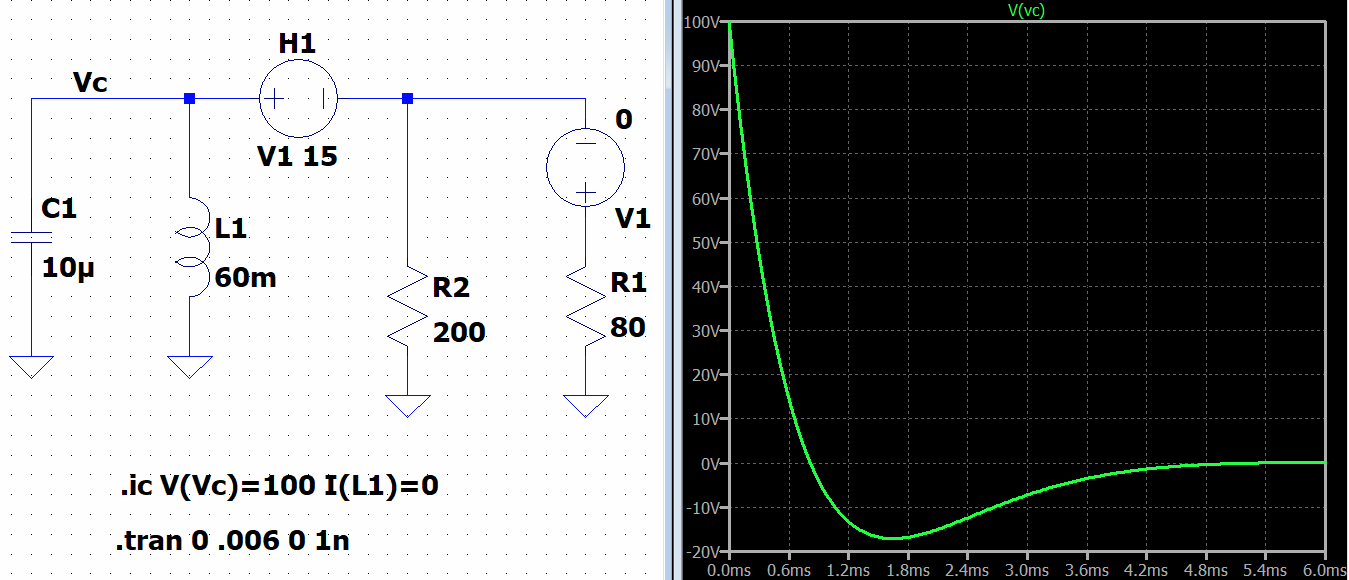The schematic with initial conditions and just following the moment after \$t=0\$ looks like this:

simulate this circuit – Schematic created using CircuitLab
Easy to work out that \$V_{_\text{A}}=\frac{V_{_\text{O}}}{1-\frac{15\:\Omega}{R_2}}\$. (Because \$V_{_\text{A}}+15\:\Omega\cdot I=V_{_\text{O}}\$ and \$I=-\frac{V_{_\text{A}}}{R_2}\$.)
So the KCL (nodal) is just:
$$C_1\frac{\text{d}}{\text{d}\,t}V_{_\text{O}}+\frac1{L_1}\int V_{_\text{O}}\:\text{d}\,t+\frac{V_{_\text{O}}}{\left(1-\frac{15\:\Omega}{R_2}\right)R_1}+\frac{V_{_\text{O}}}{\left(1-\frac{15\:\Omega}{R_2}\right)R_2}=0\:\text{A}$$
Removing the integral (take derivative), collecting terms, then in s-space:
$$\left[s^2+\frac{1}{\left(1-\frac{15\:\Omega}{R_2}\right)\cdot\left(R_1\mid\mid R_2\right)\cdot C_1}s+\frac{1}{L_1\,C_1}\right]V_{_\text{O}}=0\:\text{A}$$
Conveniently homogeneous.
Any homogeneous s-space eq. with a response of the form \$\left[s^2+a\,s+b\right]\$ solves by setting \$\alpha=-\frac12 a\$ and \$\beta=\sqrt{b-\frac14 a^2}\$, to get equivalent \$\left[\frac{\text{d}}{\text{d}\,t}-\alpha\right]^2+\beta^2\$, and finding that \$V_{_\text{O}}=\exp\left(\alpha\,t\right)\cdot\left(A_1\,\cos\left(\beta\,t\right)+A_2\,\sin\left(\beta\,t\right)\right)=A_1\,\exp\left(\alpha\,t\right)\cdot\left(\cos\left(\beta\,t\right)+\frac{A_2}{A_1}\,\sin\left(\beta\,t\right)\right)\$, since in this case \$b\ge \frac14 a^2\$ and the system is under-damped. (Otherwise, looking at hyperbolics for the over-damped case.)
\$A_1=100\:\text{V}\$ (just substitute in \$t=0\$.) So that leaves only \$A_2\$. At \$t=0\$, \$\frac1{L_1}\int V_{_\text{O}}\:\text{d}\,t=0\:\text{A}\$. So, from the first equation at \$t=0\$:
$$\left[\frac{\text{d}}{\text{d}\,t}V_{_{\text{O}}}\right]_{t=0}+\frac{V_{_{\text{O}\:t=0}}}{\left(1-\frac{15\:\Omega}{R_2}\right)\cdot\left(R_1\mid\mid R_2\right)\cdot C_1}=0\:\text{A}\\\\
\alpha\,A_1+\beta\,A_2+\frac{V_{_{\text{O}\:t=0}}}{\left(1-\frac{15\:\Omega}{R_2}\right)\cdot\left(R_1\mid\mid R_2\right)\cdot C_1}=0\:\text{A}$$
Or,
$$A_2=-\frac{V_{_{\text{O}\:t=0}}}{\beta}\cdot\left(\frac{1}{\left(1-\frac{15\:\Omega}{R_2}\right)\cdot\left(R_1\mid\mid R_2\right)\cdot C_1}+\alpha\right)$$
Plugging in \$A_1=100\:\text{V}\$, \$A_2\approx -151.26\:\text{V}\$, \$\alpha\approx -\frac1{928.57\:\mu\text{s}}\$, and \$\beta\approx 711.971455\:\frac{\text{rad}}{\text{s}}\$ find:
$${V_{_\text{O}}}_{\left(t\right)}=100\:\text{V}\cdot\exp\left(\frac{-t}{928.57\:\mu\text{s}}\right)\cdot\left[\cos\left(711.971455\:\frac{\text{rad}}{\text{s}}\cdot t\right)-1.5126\cdot\sin\left(711.971455\:\frac{\text{rad}}{\text{s}}\cdot t\right)\right]$$
Just falls out.
Here's a plot from Desmos of the above equation:

Here's a simulation result:

The data points match exactly.




